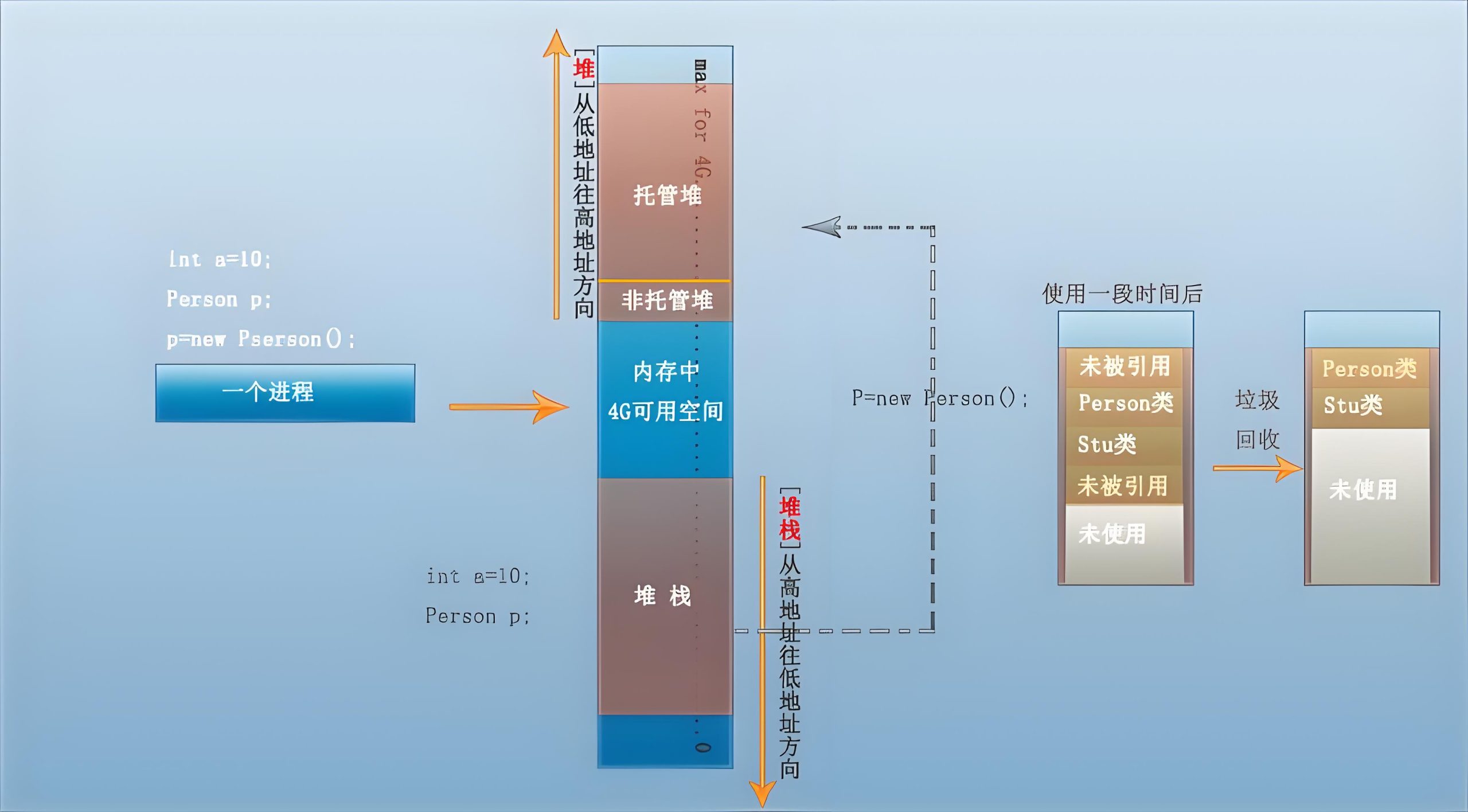Stack and Heap in Computer Memory Management
Heaps and stacks are two important concepts in computer memory management, with significant differences in memory allocation and storage methods:
1. Stack
- Storage method: The stack stores data in a Last-In, First-Out (LIFO) manner.
- Storage content: The stack mainly stores local variables, function call information (including function parameters, return addresses, etc.), and temporary data.
- Memory allocation: The memory allocation of the stack is automatically managed by the system. When a function is called, the stack space allocates space for local variables, and when the function call ends, the stack space is automatically reclaimed.
- Operation efficiency: The allocation and reclamation of the stack are very efficient, requiring only adjustment of the stack pointer.
- Size limit: The size of the stack is usually small (generally set by the operating system or compiler). If the stack space is exhausted, a stack overflow will occur.
- Lifecycle: Data in the stack usually exists during the execution of a function and is destroyed when the function exits.
2. Heap
- Storage method: The heap is a dynamic memory area with an unordered storage method, where data can be allocated and freed at any time.
- Storage content: The heap mainly stores dynamically allocated memory during program runtime (such as memory allocated through methods like new or malloc).
- Memory allocation: The allocation and reclamation of heap memory are controlled by the programmer (or through a garbage collection mechanism, such as garbage collection in Java). It is necessary to specify the memory size during allocation and manually reclaim it during release.
- Operation efficiency: Heap memory allocation and reclamation are slower because they involve more complex memory management processes (such as memory fragmentation issues).
- Size limit: The size of the heap is usually large (usually limited by system memory) and can grow dynamically.
- Lifecycle: The lifecycle of data in the heap is controlled by the programmer until the memory is explicitly freed or reclaimed by the garbage collector.
Summary of Main Differences
| Features | Stack | Heap |
| Storage method | LIFO (Last In, First Out) | Unordered dynamic allocation |
| Storage content | Local variables, function call information, temporary data | Dynamically allocated memory |
| Memory management | Automatically managed by the system | Manually managed by programmers (or garbage collection) |
| Memory allocation | Fast, stack pointer adjustment | Slow, involving more complex memory management |
| Size limit | Smaller, limited by the operating system | Larger, can grow dynamically |
| Lifecycle | Exists during function calls and is destroyed after the call ends | Controlled by the programmer, manually freed or garbage collected |
3. Memory Fragmentation
- Stack: Stack space allocation is continuous. As functions are called and exited, stack space is allocated and freed in order, and there is usually no memory fragmentation problem.
- Heap: Heap memory is dynamically allocated, and memory may be allocated and freed scattered. Over time, memory fragmentation may occur. This is a challenge in heap memory management, especially in frequent memory allocation and deallocation operations.
4. Thread Safety
- Stack: Each thread has its own stack space, and the stack itself is thread-safe because the stack spaces of different threads do not interfere with each other.
- Heap: Multiple threads may access the same heap memory, so heap memory itself is not thread-safe. To avoid conflicts caused by multiple threads accessing heap memory simultaneously, synchronization through mechanisms such as locks is required.
5. Usage Scenarios
Stack:
- Stores local variables and data related to function calls.
- Used for the call stack of recursive functions.
- Suitable for small-scale data storage with a lifecycle automatically managed by the system.
Heap:
- Stores data that needs to exist across functions or the program’s lifecycle, such as dynamically allocated arrays, linked lists, trees, and other data structures.
- Used to store large data blocks, such as images and videos.
- Suitable for scenarios where flexible control of the lifecycle and storage of large objects is required.
6. Data Access Methods
- Stack: Data in the stack is accessed sequentially, and the data at the top of the stack is always accessed first. When a function returns, the data at the top of the stack is destroyed, so stack access is more efficient.
- Heap: Data in the heap has no fixed order, the storage location is determined by the memory manager, and data access requires pointers or references.
7. Relationship Between Recursion and Stack/Heap
- In recursive calls, local variables and return addresses of functions are pushed onto the stack. The deeper the recursive call level, the more the stack is used. When the recursion depth is too large, the stack space may be exhausted, leading to a stack overflow.
- The heap is not subject to this restriction and is suitable for storing larger data or data that needs to exist for a long time. Therefore, the heap can be used in the recursive process to avoid stack overflow.
8. Memory Management Methods of Stack and Heap
- Stack: The memory of the stack is automatically managed by the operating system, and the size and structure of the stack are controlled by the operating system during program runtime.
- Heap: Heap memory is managed by programmers or automatic garbage collectors. Programmers need to explicitly allocate and free memory (such as malloc and free in C, or new and delete in C++).
9. Performance Differences
- Stack: The allocation and release of the stack are very fast because only the stack pointer needs to be adjusted.
- Heap: Heap allocation and release are relatively slow because they involve memory lookup and management.
10. Code Examples
1. Java Stack and Heap Execution Process Example
public class StackHeapExample {
// Recursive function to simulate stack usage
public static void recursiveFunction(int count) {
int localVar = count; // Memory allocated on the stack
System.out.println("Local variable (stack): " + localVar);
if (count > 0) {
recursiveFunction(count - 1); // Recursive call
}
}
public static void main(String[] args) {
// Stack variable: memory allocated on the stack
int stackVar = 100;
System.out.println("Stack variable (main): " + stackVar);
// Heap variable: memory allocated on the heap
Integer heapVar = new Integer(200);
System.out.println("Heap variable: " + heapVar);
// Call the recursive function
recursiveFunction(3);
}
}Notes:
- Stack: stackVar and the recursive function localVar are allocated memory on the stack. As functions are called and return, data on the stack is pushed and popped in sequence.
- Heap: heapVar uses new Integer() to allocate memory on the heap. Data on the heap will not be destroyed with the end of function calls and needs manual memory management (managing heap memory through garbage collection in Java).
Execution Process:
- stackVar is allocated in the main function and stored in the stack.
- heapVar is allocated in the heap and stores the integer value 200.
- Each recursive call pushes the local variable localVar onto the stack, which is popped when the recursion ends.
- The stack space changes continuously as functions enter and exit, while objects on the heap (such as heapVar) are not automatically destroyed until the garbage collector reclaims them.
2. Kotlin Stack and Heap Execution Process Example
fun recursiveFunction(count: Int) {
val localVar = count // Memory allocated on the stack
println("Local variable (stack): $localVar")
if (count > 0) {
recursiveFunction(count - 1) // Recursive call
}
}
fun main() {
// Stack variable: memory allocated on the stack
val stackVar = 100
println("Stack variable (main): $stackVar")
// Heap variable: memory allocated on the heap
val heapVar = 200
println("Heap variable: $heapVar")
// Call the recursive function
recursiveFunction(3)
}Notes:
- Stack: stackVar and the recursive function localVar are allocated memory on the stack.
- Heap: Although heapVar is a local variable, it is essentially allocated on the heap because it is an object other than a basic data type.
Execution Process:
- stackVar is allocated in the main function and stored in the stack.
- heapVar is allocated on the heap and stores the integer value 200.
- Each recursive call pushes the local variable localVar onto the stack, which is popped when the recursion ends.
3. Go Stack and Heap Execution Process Example
package main
import "fmt"
func recursiveFunction(count int) {
localVar := count // Memory allocated on the stack
fmt.Println("Local variable (stack):", localVar)
if (count > 0) {
recursiveFunction(count - 1) // Recursive call
}
}
func main() {
// Stack variable: memory allocated on the stack
stackVar := 100
fmt.Println("Stack variable (main):", stackVar)
// Heap variable: memory allocated on the heap
heapVar := new(int) // Use `new` to allocate memory on the heap
*heapVar = 200
fmt.Println("Heap variable:", *heapVar)
// Call the recursive function
recursiveFunction(3)
}Notes:
- Stack: stackVar and the recursive function localVar are allocated memory on the stack.
- Heap: heapVar allocates memory using new(int) and points to integer type data in the heap.
Execution Process:
- stackVar is allocated in the main function and stored in the stack.
- heapVar allocates memory on the heap using new(int) and stores the value 200 in the heap.
- Each recursive call pushes the local variable localVar onto the stack, which is popped when the recursion ends.
Summary
- Stack memory allocation is fast and automatic, suitable for local, short-term data storage, but with small space and a short lifecycle; while heap memory allocation is flexible, can store larger-scale data, suitable for long-term storage, but is more complex to manage.
- In Java and Kotlin, the memory management of stacks and heaps is automatically managed by the JVM. Stacks are used to store local variables, and heaps are used to store dynamically allocated objects.
- In Go, the management of stacks and heaps is also automatic. Stacks are used for local variables, and heaps are used for objects allocated through new.


